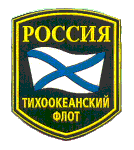






 The Pacific Fleet and the Northern Fleet are rated as the two most powerful Russian naval forces. Pacific Fleet headquarters is in Vladivostok, with additional home ports in Petropavlovsk-Kamchatskiy, Magadan, and Sovetskaya Gavan'. The Pacific Fleet includes eighteen nuclear submarines that are operationally subordinate to the Ministry of Defense and based at Pavlovsk and Rybachiy. The blue-water striking power of the Pacific Fleet lies in thirty-four nonnuclear submarines and forty-nine principal surface combatants.
The Pacific Fleet and the Northern Fleet are rated as the two most powerful Russian naval forces. Pacific Fleet headquarters is in Vladivostok, with additional home ports in Petropavlovsk-Kamchatskiy, Magadan, and Sovetskaya Gavan'. The Pacific Fleet includes eighteen nuclear submarines that are operationally subordinate to the Ministry of Defense and based at Pavlovsk and Rybachiy. The blue-water striking power of the Pacific Fleet lies in thirty-four nonnuclear submarines and forty-nine principal surface combatants.
The air power of the Pacific Fleet consisted in the mid-1990s of the 250 combat aircraft and helicopters of the Pacific Fleet Air Force, all of which are land-based. Its most powerful strike force was two bomber regiments stationed at Alekseyevka. Each regiment consisted of thirty supersonic Tu-22M Backfire aircraft. The land power of the Pacific Fleet consisted of one naval infantry division and a coastal defense division. The naval infantry division included more than half of the total manpower in the Russian naval infantry. Following the pattern established elsewhere in the naval infantry, in the mid-1990s the Pacific Fleet infantry was reorganized into brigades.
Russia is a Pacific nation with national interests in the Asia-Pacific region. While smaller than in the Soviet era, today's Russian Pacific Fleet is built around a core of modern combatants. The Russian Pacific Fleet demonstrates continued resolve to increase combat readiness despite funding shortfalls. Russian Pacific Fleet submarines carry out missions of strategic deterrence, protection of strategic assets, regional security, and training for anti-surface warfare. Additionally, surface operations are active and annual operations include two major training exercises and numerous smaller training events with the 10th Eskadra of surface ships. A joint headquarters which commands the land, naval, and air units stationed in the Kamchatka Peninsula was established in the late 1990s.
The Russian Navy maintains the capability to carry out "defense of the homeland" operations and retains the force structure for out-of-area submarine and surface combatant operations. Beginning in 1994 Pacific Fleet sent an Oscar submarine into the western or central Pacific each year. Normally these deployments coincide with a Pacific Ocean transit of a US aircraft carrier battle group. Historically the Russian Pacific Ocean Fleet Air Force would send a pair of Tu-95/Bear Gs, and later Tu-142/Bear F, to monitor American battle groups transiting the Pacific. The intercepts took place in what became known as "Bear Box," an area approximately 1,000 nautical miles east of Japan. Beneath the icy waters of the Sea of Okhotsk, north of Hokkaido and west of Kamchatka, strategic nuclear submarines cruise, and the sea is itself ringed with missiles, communication systems and other fortifications. The Kurile Islands [known in Japan as the Northern Territories] consist of Shikotan Island and the Habomais islets, as well as two larger islands, Etorofu and Kunashiri. The Yalta Agreement specified that the Kurile Islands were to be handed over to the Soviet Union in return for its participation in the war against Japan. In the peace treaty, Japan renounced its rights to the Kuril Islands but the treaty did not specify what nation was to receive them. The Kuriles were militarised in the 1970s and 1980s in response to new developments in strategic deterrence. The Sea of Okhotsk became a bastion for Soviet SLBM submarines based at Petropavlovsk on the Kamchatka Peninsula. Successive Japanese governments have been steadfast in their demand that Russia return the disputed islands to Japan. Vladivostok, home-port of the Russian Pacific Fleet, has a complement of at least 65 major surface combat ships, 50 nuclear and 25 non-nuclear submarines. Russia's longstanding desire for a Pacific port was realized with the foundation of Vladivostok in 1860. The city's nomination as the headquarters of the Russian Pacific fleet in the 1870s brought further growth. The lack of adequate transportation links between European Russia and its Far Eastern provinces was an obvious problem. In 1891, Czar Alexander III drew up plans for the Trans-Siberian Railway and initiated its construction. Despite the enormity of the project, a continuous route was completed in 1905, having been rushed to completion by the outbreak of the Russo-Japanese War the year before. Vladivostok became Russia's main naval base in the East after Port Arthur (located in Chinese territory and ceded to Russia in 1898) fell in January 1905, during the Russo-Japanese war. During the Soviet era, Vladivostok's military role eclipsed its trading function. It has maintained its naval importance as the headquarters of the Russian Pacific Fleet. The US Seventh Fleet sends one or two Navy ships a year to Vladivostok for a port call -- much fewer than visit most ports of call in the Pacific. US and Russian Navies train together during exercise Cooperation from the Sea. First conducted in 1994, US Sailors and Marines simulate relief efforts to a community struck by natural disaster. The scenarios include an earthquake with mass casualties and ensuing fires. Cooperation from the Sea was conducted in the Khasan region of Primorye in 1994, off the coast of Hawaii in 1995, and Vladivostok in 1998. Relations between Moscow and Beijing are based on a strategic partnership agreement signed in 1996. China and Russia have steadily increased military trade relations, and China has become the top client for Russia's military business. In October 1999 Russian and Chinese navies conducted their first joint naval exercise since 1949. Russian warships included the Pacific Fleet flagship Varyag and destroyer Burgy. The two Russian vessels participated in joint exercises with warships from China's Eastern Fleet.In 1997 former Russian Pacific Fleet Commander Admiral Khmelnov was given a four-year suspended sentence for abuse of office during his 1994-96 tenure. Subsequently, Rear Admiral Nikolai Germanov, former Commander of the Maritime Krai (Vladivostok) Submarine Force, was indicted for organizing selling materiel on the black market.
Grigory Pasko, a naval captain and correspondent for the newspaper of the Russian Pacific Fleet Boyevaya Vakhta, was charged in November 1997 with espionage and revealing state secrets. The Federal Security Services (FSB) classified the case a state secret, making it difficult for his lawyers to mount a proper defence. Pasko's "crime" was reporting on the Russian Navy's illegal dumping of nuclear waste in the Sea of Japan. Pasko showed the threat to the environment caused by accidents in the decaying Russian nuclear submarine fleet. Because of a shortage of money and high-level corruption in the Pacific Fleet, the Russian navy had dumped liquid and solid nuclear waste off the coast of Vladivostok. The authorities admitted that none of the facts he had published revealed state secrets or endangered national security. In July 1999 Pasko was released by the Russian Pacific Fleet military court in Vladivostok after it found that the prosecution lacked evidence to support the espionage charges against him. The court found Grigory Pasko guilty of "abuse of office" under the Russian Criminal Code, and sentenced him to the maximum term of three years' imprisonment. The court relieved Pasko of the obligation to serve the sentence, under the provisions of a recently adopted amnesty law for prisoners and detainees.